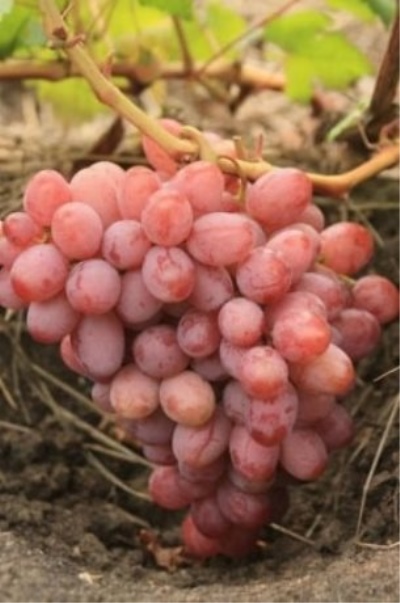
- Authors: The Krainov family
- Berry color: pink
- Taste: nutmeg
- Ripening period: early
- Ripening period, days: 110-115
- Frost resistance, ° C: -24
- Name synonyms: Gourmet 3-6
- Bunch weight, g: 600-1200
- Flower type: functionally female
- Peeling: No
Breeders continue to amaze grape breeders with more and more new varieties. From such modern new varieties, bred no more than 10 years ago, the variety Gurman Lakomka can be distinguished.
Breeding history
This hybrid variety was bred by the famous amateur breeder Viktor Nikolaevich Krainov. In total, 5 similar varieties were bred under one name - Gourmet. All these varieties are united by a specific varietal taste of berries. They were obtained by crossing the grapes Kishmish Radiant and Talisman. The second name of the variety is Gourmet 3-6.
Geography of distribution
This variety is widespread in warm regions of Russia and Belarus, Ukraine and Moldova.
Description
The Gourmet Lakomka grape variety is widespread not only in individual gardens and vineyards, but also in the mass cultivation of this culture. In addition to the nutmeg taste and aroma of berries, they have a large weight of 8-10 grams, while they are stored for a long time in a dry, cool room. The plant is relatively unpretentious and has a number of the above advantages. Therefore, this variety is very popular with both amateur gardeners and professional winegrowers.
Ripening period
This grape variety is early maturing (it takes only 110-115 days from bud set to harvest).
Bunches
The berries are collected in conical, large clusters of medium density. On average, the weight of one bunch is 600-1200 grams. The variety is not susceptible to peas even under unfavorable conditions, all berries on bunches ripen evenly and are not prone to rotting.
Berries
Berries are oval, pinkish in color, with a dense, crunchy pulp. They do not crack, have a dense skin.
Taste
The Gourmet Gourmet grape has a well-perceptible nutmeg taste, the berries are sweet and aromatic.
Yield
It is appreciated among winegrowers Gourmet Lakomka not only for its specific taste and early ripening period, but also for its high yield (under favorable conditions, up to 8 kg of berries are harvested from the bush).


Growing features
The variety is grown in open ground only under the condition of reliable shelter for the winter. In climates with cold, little snowy winters, grapes are recommended to be grown in a greenhouse, since the frost resistance of Gourmet Gourmet is only -24 degrees Celsius. They planted it in sunny, wind-protected areas.
Landing
The Gourmet Lakomka variety is propagated by cuttings, the cuttings take root well, they quickly develop the root system. Often they are grafted onto more resistant plants or an old grape bush. Before this method of reproduction, the issue should be well studied, while caring for the grafted plant requires special and more thorough.

Pollination
The flowers of the fruit variety Gourmet Lakomka are female type, they are pollinated with flowers on neighboring bushes, with the same flowering period, and no worse than plants with bisexual flowers. When breeding this type of grape, it is necessary to take care of the presence of varieties with male flowers or bisexual types of flowers on the site.
Pruning
For better growth, the fruiting shoot is cut off, leaving 6-8 eyes. The bush is formed in 22-24 shoots - this amount is enough for good growth and abundant fruiting.



Top dressing
In the process of growth and maturation, the plant needs root and foliar feeding. Before the flowering period, potassium-phosphorus substances are used, after the formation of flowers, additional fertilizing containing trace elements is added to them.
Frost resistance and the need for shelter
As mentioned above, the frost resistance of the Gurman Lakomka variety is up to -24 degrees. Shelter for the winter is necessary.

Diseases and pests
As a preventive measure against fungal infections, the leaves of the plant are sprayed with various biological preparations. The treatment is carried out periodically, because after precipitation falls, the protective layer of the agent on the leaves needs to be renewed. Systemic fungicides can also be used to protect grapes (the effect of such treatments lasts longer than when using contact protective substances, and newly formed leaves, buds and ovaries are also protected).
Although the variety is resistant to many types of grape diseases, it is weakly resistant to oidium and anthracnose. Chemicals are used to protect against damage by these diseases. In addition, pinching and tying bushes are used to combat powdery mildew, as well as timely removal of weeds and loosening of the soil.
In addition to diseases, birds and insects can spoil crops and harm grapes. Protective nets are put on the bunches from birds, and to protect against insects, for example, from a spider mite, which often infects a plant, the bushes are treated with special agents.

If a grape is exposed to any disease or insect, this always affects its appearance.
Storage
The berries of this hybrid are used for fresh consumption, and also frozen for the winter. Even without freezing at temperatures up to +5 degrees, grapes retain their freshness for a long time. In a cool, disinfected place, it can lie until spring.











































































